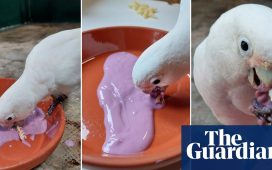Birds-of-paradise are known for their bright and colourful plumage, but it turns out they are even more dazzling than previously thought.
Researchers have found 37 of the 45 species show biofluorescence – in other words, patches of their plumage or other body parts absorb UV or blue light, and emit light at lower frequencies.
“At a minimum, it would make these biofluorescent areas brighter – a yellow feather may be more green-yellow, a white feather may be brighter and slightly more green-yellow,” said Dr Rene Martin from the American Museum of Natural History in New York, who was first author of the study.
Published in the journal Royal Society Open Science, Martin and colleagues reported how they studied preserved specimens of each bird-of-paradise species, held in the ornithology collection at the American Museum of Natural History.
The team placed males and females of each species under blue light in a dark room and recorded the wavelengths and intensity of light emitted. In some cases they also shone UV light on the skins.
The results revealed that males of 21 species showed biofluorescence on parts of their plumage such as their head, neck, belly and tail feathers, or on fleshy lobes known as face wattles. In addition, these species plus an additional 16 species showed – or were deemed likely to show – biofluorescence in their inner mouth and throat.
Females of 36 of these species, and most likely all 37, also showed biofluorescence. Several showed this on their chest and belly, or on feathers that form an eye stripe on the side of their head.
The team said the emitted light ranged from light or teal blue wavelengths to green and green-yellow.
“It may not have the effect of making something look different, but becoming brighter and more eye-catching,” said Martin.
The team added that biofluorescence did not occur in species in the genera of Lycocorax, Manucodia and Phonygammus. That, they said, fits with the idea that biofluorescence was present in the common ancestor of all birds-of-paradise, but was lost in the ancestor of these three groups.
The researchers said the elaborate courtship displays shown by males of many of the biofluorescent species would be enhanced by the phenomenon – for example, male Lophorina gape their mouths open towards females while performing.
“Male birds-of-paradise often have these patches next to stark black [or] dark plumage, so the added effect of biofluorescence may aid in making these signal areas even brighter while being used during displays,” added Martin.
In females, however, the phenomenon might have a different function. “The location and patterns of their biofluorescent plumage of many species are much more in line with its possible use as camouflage,” she said.
Martin added that the research sheds fresh light on the well studied birds. “Even a charismatic group like the birds-of-paradise, that have been studied extensively, can still offer new insights into avian vision, behaviour and morphology,” she said.














